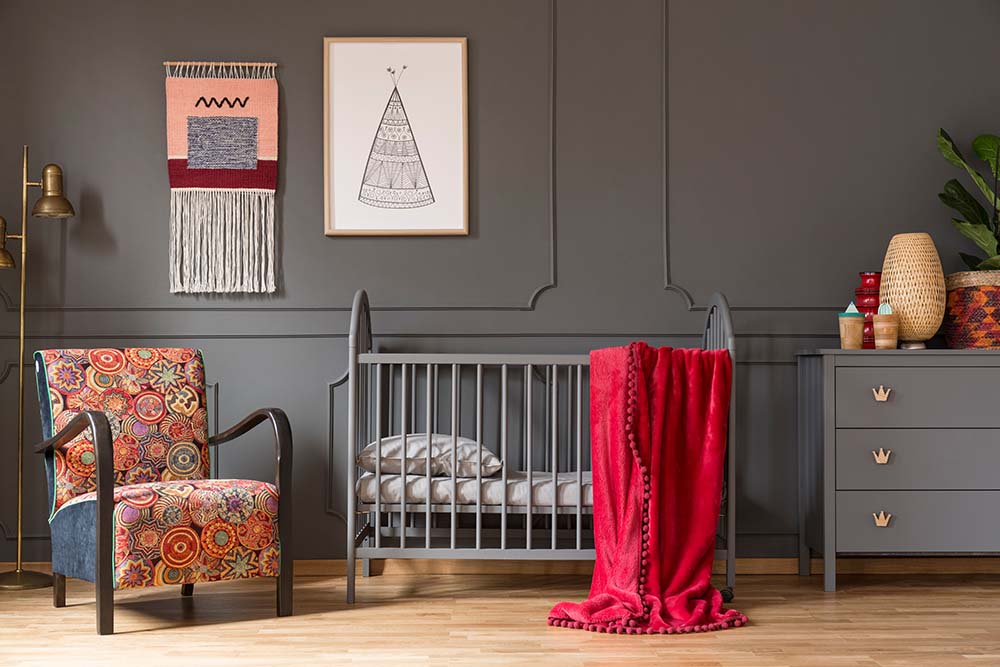This year has been the year for baby announcements all around me, and one thing that all my friends have been worrying about is the baby’s nursery. While the thought of a baby bouncing around in a sweet and dreamy nursery gets you all warm and fuzzy, the work of creating a safe, comfy room for a baby can feel overwhelming.
Planning a nursery takes a lot of labour, and while most parents-to-be get caught up in the decor details including toys, frames, wallpapers, it’s important to double-check that you’ve got the basics covered and within the set budget. Whether you’re designing for a girl, boy or going gender-neutral, with so many themes, styles and baby items available, it can be difficult to figure out which ones are really worth investing in.

Here’s A Step-By-Step On Setting Up A Nursery
#1 Think Of The Central Idea
Think of what makes you happy, zero in on a single item that inspires the overall design, think wallpaper pattern, maybe it’s just a crib or another piece of furniture that you set your heart to. Interior designers this the ‘seed’ item—it’s the item from which the rest of the design grows.

#2 Keep It Minimal
A nursery design is not a permanent one, your toddler will eventually outgrow it and will want toys and posters of their liking. Always begin with a light or nude base for the walls and then make additions according to your theme - furniture, lighting, wallpaper, artwork, bedding, curtains, toys etc. Choosing calming colours such as white or pastels for the walls, gives you ample of chance to do a lot more with the room. Make sure to opt for no or low VOC paint.

#3 Visualise Your Movements
Walk around the room you are setting up the nursery in, think of your movements with a baby in tow. Measure your space, and make decisions based on distance, convenience, and most importantly safety. Create zones for where your baby will sleep, where you will put the changing table, the play mat and most importantly the seat you will be spending most of your time in.

#4 Decorate, But Don’t Splurge
I have often seen parents go on a spending spree without keeping track of what they really need. Take stock of what you’ve been gifted before you go and splurge on big ticket items. Consider buying furniture you could later use for example a vintage dresser that can be moved into your room or used by your child if they like it, a nice reading chair that can be moved to the living room or patio. You could also invest in multipurpose nursery furniture – crib with built-in drawers, storage boxes with changing toppers, or dressers with an attached changing table and storage.

#5 Focus on Making It A Comfortable Environment
The most important for the baby and parents is getting them set on a sleep schedule. Lighting, temperature, sound are all contributing factors. Select softer colours and material for the curtains, change the bedding according to the weather. Invest in lamps and lights with dimmers. Think of sound proofing the doors, maybe add an extra layer of rugs or drapes to absorb the exterior sound.

Essentials: This Checklist Will Guide You Through The Process
Crib or Bassinet
• Side Slats/ planks no more than 2 3/8 inches apart
• Corner posts no more than 1/16 of an inch above frame
• No cut-outs in headboard or footboard
• Top rails at least 26 inches above mattress
Bedding
• Firm and flat mattress
• Mattress that fits comfortably in crib with no more or less than two fingers should fit between mattress and crib
• Fitted sheets
• Washable mattress pads
• Soft, cotton blankets for summers
• Comforters for winters
• Side pillows
Changing Table
• Waterproof Diaper Changing Pad
• Washable changing pad cover
• Rubber strips on the bottom for extra grip
• Safety straps to keep baby from wiggling, rolling or falling
Closet Storage Organizer / Storage Baskets
Dresser
Diaper Dispenser / Diaper Disposal Systems
Rocking Chair Or Arm Chair
Toy Box
Music box, sound machine or CD player
Crib mobile (remove when baby can support self on hands and knees)
Baby monitor
Nightlight